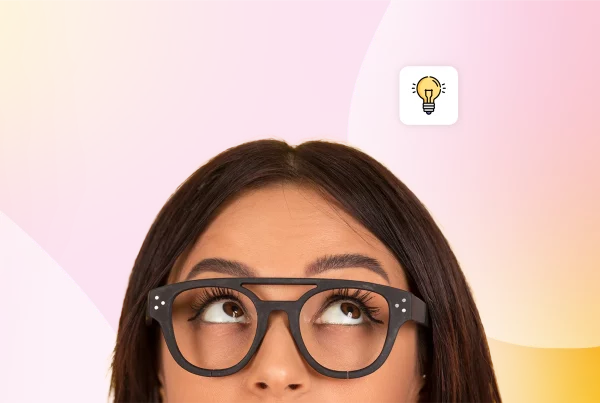Did you know that only 12% of organisations truly understand how their employees prefer to learn? 😲🤔
As we look ahead to 2025, having a strong learning and development programme that caters to the individual needs of your employees is no longer just a nice-to-have—it’s ESSENTIAL if you want your workplace to do more than just get by. 🌱
Many organisations still have a lot of work to do to align with the L&D trends that will help shape the future workforce. But don’t worry if this feels daunting to you; we’ve got you covered!
Join us as we take a deep dive into the top 11 learning and development trends that are crucial for upskilling and empowering your team in 2025 and beyond.
From cutting-edge AI-driven learning experiences to immersive learning, every single one of these trends will help you build a dynamic, future-proof learning environment that’s ready to meet the challenges of tomorrow’s workforce. 🌟
11 Learning and Development Trends for 2025
- AI-Driven Learning Experiences
- Skills-Based Talent Management
- Hybrid Learning Models
- Focus on Emotional Intelligence
- Immersive learning
- Integration of Learning with Employee Experience
- Social and Collaborative Learning
- Knowledge Management and Curation
- Employee Empowerment & Self-Directed Learning
- Employee-Generated Content
- AI-Powered Learning Assistants
Let’s take a look at each trend in more detail…👇
1. AI-Driven Learning Experiences 🤖
Unsurprisingly, in 2025, AI and machine learning will continue to be game-changers in delivering a truly personalised learning experience. 🎯
However, despite AI’s growing role in L&D, 59% of learning leaders still lack the necessary data to guide their practices effectively, highlighting a gap between the availability of accurate data and its practical application.
How to action it
Invest in an AI-powered learning and development platform like Thirst, which can provide your learners with customised learning recommendations and personalised content.
By analysing employee behaviour, their preferences, and other performance data, a smart learning platform like Thirst can also recommend tailored learning paths, making training more relevant and effective for your learners. 📈
With a system like Thirst, your team breaks free from the limitations of a one-size-fits-all learning approach. This means your learners can enjoy the freedom to learn at their own pace in the best way that suits their needs. 🧩 🎯
Trust us, your employees will thank you for it! 🙌
2. Skills-Based Talent Management 🎓
Wave goodbye to traditional job roles and hello to a more skills-based approach! 🌟
In 2025, organisations will be focusing more on developing specific skills rather than training for predefined roles. This allows for greater agility and helps in filling skills gaps more efficiently. 🛠️
Why It Matters:
With a staggering 94% of UK workers expected to need reskilling by 2030 and 30% of businesses struggling to grow due to skill shortages over the past year, the need for a skills-based approach has never been more critical.
How to action it
Ensure your L&D strategy aligns with the evolving skills required across your organisation. 🚀
Align your L&D Strategy with Skills Needs
Conduct regular skills assessments to identify current and future skill needs and design training programs that effectively address these gaps.
Promote Continuous Learning
You can’t go wrong with a culture of continuous learning where employees are encouraged to pursue new skills and knowledge on an ongoing basis. We recommend offering flexible learning options such as online courses, workshops, and on-the-job training to support this culture and keep employees engaged.
Track and Measure Skill Development
Implement an LXP like Thirst to track and measure skills development and training effectiveness.
Use the data and analytics you receive to evaluate the impact of your L&D programs, identify areas for improvement, and ensure that skill development aligns with your organisational objectives.
Upskilling and reskilling: Why it is the future of work
3. Hybrid Learning Models 🌐
As hybrid work becomes the new norm, so does the need for hybrid learning models that blend various training formats.
Gone are the days when employees had to be physically present to learn effectively.
Today, the most successful learning and development programs integrate online, in-person, and on-the-job training seamlessly. 💻📚
Hybrid learning models ensure that training is accessible and adaptable to the needs of a diverse workforce.
How to action it
Start by creating a hybrid learning strategy that takes full advantage of different learning styles and needs. Virtual classrooms, webinars, and mobile learning platforms can perfectly complement traditional in-person sessions. 🧑💻👩🏫
By offering this flexibility, you can empower your team to learn in ways that align with their busy schedules and preferred methods.
This increases employee engagement and knowledge retention, ensuring that no employee is left behind, regardless of their location!
Pretty good, eh?
4. Focus on Emotional Intelligence💡
As automation and AI increasingly take over routine technical tasks, the value of soft skills in the workplace is skyrocketing.
Emotional intelligence is becoming just as critical as technical expertise.
Yep, that’s right, skills like communication, leadership, empathy, and emotional intelligence are now at the forefront of effective collaboration and management. 🧠
These skills are not just nice-to-haves but essential for creating a more productive workplace that encourages better teamwork, conflict resolution, and overall job satisfaction. 🤝
How to action it
Prioritising soft skills training in your L&D programs is key to developing emotionally intelligent leaders and teams.
Why not roll out experiential learning techniques like role-playing, simulations, and real-world scenarios into your training sessions? 🎭
These methods provide your employees with hands-on experience in managing interpersonal challenges and honing their communication and leadership abilities.
Not least, by practising these skills in a safe and structured environment, employees can build confidence and competence in their emotional intelligence, leading to a more harmonious and effective workplace.
Win-Win! 🏆
5. Immersive learning 🕶️
In 2025, get ready to revolutionise your learning experience with the power of immersive technologies!
Virtual Reality (VR) and Augmented Reality (AR) can transform how we approach education and training by creating engaging, interactive, and highly realistic scenarios.
Whether your team is looking to master complex technical skills, navigate intricate safety protocols, or enhance their customer service interactions, these technologies provide a unique hands-on experience. 🚁
How to action it
Invest in VR/AR Technologies
Consider investing in VR and AR tools and platforms that are tailored to your specific training needs.
For instance:
- Safety Training: Use VR to simulate hazardous environments or emergencies, allowing learners to practise safety procedures in a controlled, virtual setting. This hands-on experience can improve preparedness and confidence.
- Customer Interactions: Develop VR scenarios that replicate customer service interactions. This will enable trainees to practise communication skills and problem-solving in a simulated environment, helping them build confidence and refine interpersonal skills.
7 ways to boost your learner engagement
6. Integration of Learning with Employee Experience
The future of learning is not just about acquiring new skills in isolation; it’s about embedding learning opportunities into the broader fabric of the workplace experience.
By integrating learning with overall employee experience initiatives, organisations like yours can create a more supportive and open environment. 😊
How to action it
Align Learning Objectives with Employee Goals
Develop learning programs that are directly tied to your employees’ broader career goals and aspirations.
By understanding their individual and collective ambitions, you can design training initiatives that support their personal growth and professional development. This alignment helps ensure that learning is not just a checkbox but a meaningful part of their career trajectory.
Integrate Learning into Onboarding
Make learning a fundamental part of onboarding. New hires should be introduced to both the organisational culture and the skills they need to succeed from day one.
An integrated onboarding experience that combines learning with practical, role-specific training can accelerate productivity and help new employees feel more connected to your business.
Embed Learning into Daily Workflows
Bolster continuous learning by integrating educational opportunities into daily tasks.
Use tools like just-in-time training, microlearning modules, and knowledge-sharing platforms like Thirst that employees can access as they perform their regular duties. This approach allows employees to learn in the context of their work, making it more applicable and immediately beneficial.
7. Social and Collaborative Learning 🤝
Learning is more fun together! 🎉
Social learning, where employees learn from each other through collaboration and knowledge sharing, will gain even more traction in 2025 and beyond.
Online communities, forums, and collaborative tools will be the catalysts for this trend. 💬
How to action it
Promote social learning by creating opportunities for employees to share knowledge and collaborate on a regular basis. 🗣️
Did you know you can transform your organisation’s knowledge sharing with Thirst, featuring a suite of tools designed with real people in mind?
Here’s how…
Certificates & Badges🥇
Empower your employees to showcase their skills and achievements with personalised certificates and badges, celebrating their milestones and expertise.
Live Events 🎟️
Host engaging virtual and hybrid learning sessions with ease, connecting your team worldwide for interactive and impactful experiences.
Community Spirit 🧑🏻🤝🧑🏻
Create a vibrant community with Thirst’s features that encourage participation, discussions, and active knowledge sharing, keeping your team engaged and connected at all times!
8. Knowledge Management and Curation 📚
Information overload is real! 😵
L&D’s role in 2025 will expand to include knowledge management and curation, helping employees easily find and use the information they need. 🧠
How to action it
Implement knowledge management systems and tools that allow employees to access and share information easily. In 2025, it is crucial to develop strategies for curating content to avoid overwhelming learners. 🧳
Implement Knowledge Management Systems (KMS)
Did you know that the LXP market is predicted to grow from $508.5 million in 2020 to over $2 billion by 2026, driven by the need for personalised learning experiences that go beyond traditional training models?
Now is a great time to invest in a learning system that provides a centralised platform for storing, organising, and retrieving information.
Look for platforms like Thirst that offer features such as searchable databases, document management, version control, and collaborative spaces.
It goes without saying that this helps streamline access to critical information and facilitates easier sharing among team members.
Promote User-Generated Content
Encourage employees to contribute to the knowledge base by sharing their expertise, insights, and best practices. Ensure that they are able to easily add and update content, such as by submitting articles, creating how-to guides, or providing feedback on existing resources.
Looking for an LMS or LXP?
Check out LXP vs LMS: What’s the Difference?
9. Employee Empowerment & Self-Directed Learning 🚀
Empowering employees to control their learning journeys will be a big focus in 2025. 🌟
Self-directed learning platforms that let employees choose what, when, and how they learn will become increasingly popular. 📅
How to action it
Offer a Diverse Array of Learning Resources
Ensure that the learning platforms you provide offer a broad spectrum of resources, including online courses, webinars, eBooks, podcasts, and industry articles.
Encourage Goal Setting
Guide your employees in setting their own learning goals and developing personalised learning plans.
Provide framework or goal-setting tools that help employees define clear, actionable objectives and identify the steps needed to achieve them. Encourage regular reviews and updates of these goals to maintain motivation and track progress.
Support Flexible Learning Opportunities 🛤️
Allow employees to choose when and where they engage with learning materials to create an environment that supports flexibility in learning. This flexibility accommodates various schedules and learning styles, ensuring that your employees can effectively integrate learning into their daily routines.
Are you looking for a learning platform?
What is the difference between LXP and LMS?
10. Employee-Generated Content 🎥
Employees will become the content creators! 🎬
Expect to see more tutorials, videos, and articles created by employees themselves.
This user-generated content will enrich the organisation’s learning ecosystem, making it more diverse and relevant. 🧑🏫
How to action it
Encourage and empower your employees to create and share their own content. Provide platforms where they can showcase their knowledge and experiences with colleagues.
Invest in platforms and tools that facilitate easy content creation and sharing.
This might include internal wikis, knowledge bases, forums, or social collaboration tools.
Ensure these platforms are user-friendly and accessible so employees can easily upload, share, and interact with content.
Promote Collaboration and Feedback
Create regular opportunities for employees to collaborate on content creation and provide feedback on each other’s work. This could include peer review systems, collaborative content projects, or feedback sessions.
Provide Recognition and Rewards
Recognise and reward employees who contribute high-quality, impactful content. Implement recognition programs, such as awards or incentives, to celebrate their contributions.
11. AI-Powered Learning Assistants 🧠
AI-powered learning assistants are set to become your new best friend at work. 🤖
These assistants will provide personalised learning recommendations, answer questions, and guide your employees through complex tasks in real-time. 🕒
How to action it
Implement AI-powered tools like chatbots or virtual assistants that support on-the-job learning.
These handy assistants can help employees find the right resources, provide instant feedback, and offer guidance as they work through challenges. 💪
Final Words: The State of L&D in 2025 🌟
Wow, that was a deep dive! 🎉
If you’ve made it to the end, we hope you’ve picked up some valuable insights into what 2025 has in store for the learning and development industry and what action to take to ensure you don’t miss out. 🚀
It’s clear that Learning and Development is on an exciting path!
With AI, hybrid models, and a focus on emotional intelligence, the future is all about personalisation, collaboration, and empowerment.
So, are YOU ready to embrace these trends and take your L&D strategy to the next level? 💪🌟
Got 2 Minutes?
If your organisation is struggling with disengaged learners, Thirst has the solution. 🔥
Thirst is an AI-powered learning platform that helps L&D teams of all sizes boost learner engagement and create experiences tailored to today’s learners.
Take a guided tour today and see Thirst in action.
For more e-learning insights, resources and information, discover the Thirst blog.
You may also enjoy:
10 Ways to Overcome the Forgetting Curve | 12 Onboarding Best Practices for New Employees | How to Engage Gen Z Learners the Right Way







